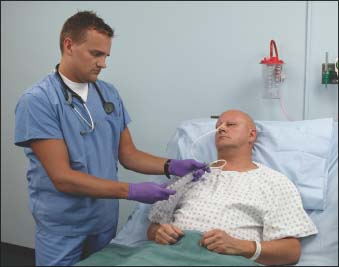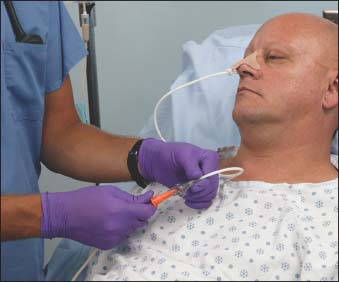Tube Feedings
Tube feedings involve delivery of a liquid feeding formula directly to the stomach (known as gastric gavage). Tube feedings typically are indicated for a patient who can’t eat normally because of dysphagia or oral or esophageal obstruction or injury. They also may be given to an unconscious or intubated patient or to a patient recovering from GI tract surgery who can’t ingest food orally.
Duodenal or jejunal feedings decrease the risk of aspiration because the formula bypasses the pylorus. Jejunal feedings result in reduced pancreatic stimulation; as a result, the patient may require an elemental diet.
Enteral feedings should be started postoperatively in surgical patients without waiting for flatus or a bowel movement; current literature indicates within 24 to 48 hours.
Patients usually receive tube feedings on an intermittent schedule. However, for duodenal or jejunal feedings, most patients seem to better tolerate a continuous slow drip.
Liquid nutrient solutions come in various formulas for administration through a nasogastric tube, small-bore feeding tube, gastrostomy or jejunostomy tube, percutaneous endoscopic gastrostomy tube, or gastrostomy feeding button. Tube feeding is contraindicated in patients who have no bowel sounds or a suspected bowel obstruction, upper GI bleeding, or intractable vomiting and diarrhea.
Equipment
Feeding formula ▪ gloves ▪ graduated container ▪ sterile water ▪ gavage bag with tubing and flow regulator clamp or enteral administration set containing a gavage container, drip chamber, roller clamp or flow regulator, tube connector, and Y-connector (if needed) ▪ towel or linen-saver pad ▪ 60-mL syringe ▪ pH test strip ▪ Optional: infusion controller, tubing set (for continuous administration), adapter to connect gavage tubing to feeding tube, carbon dioxide (CO2) detector designed for gastric tube placement.
A bulb syringe or large catheter-tip syringe may be substituted for a gavage bag after the patient demonstrates tolerance for a gravity-drip infusion. The doctor may order an infusion pump to ensure accurate delivery of the prescribed formula.
Preparation of Equipment
Be sure to refrigerate formulas prepared in the dietary department or pharmacy. Refrigerate commercial formulas only after opening them. Check the formula against the doctor’s orders. Check the date on all formula containers, discarding expired commercial formula. Use powdered formula within 24 hours of mixing.1 Always shake the container well to mix the solution thoroughly.
Allow the formula to warm to room temperature before administration. Cold formula can increase the chance of diarrhea. Never warm it over direct heat or in a microwave because heat may curdle the formula or change its chemical composition. Also, hot formula may injure the patient.
Perform hand hygiene and put on gloves.2,3,4,5 Pour 60 mL of water into the graduated container. After closing the flow clamp on the administration set, pour the appropriate amount of formula into the gavage bag. Hang no more than a 4-hour supply at one time to prevent bacterial growth.
If using a sterile, decanted tube-feeding formula, attach the administration set directly to the container. Sterile, decanted formula should have a hang time of 8 hours.
Open the flow clamp on the administration set to remove air from the lines; doing so keeps air from entering the patient’s stomach and causing distention and discomfort.
Implementation
Provide privacy.
Confirm the patient’s identity using at least two patient identifiers according to your facility’s policy.6
Inform the patient that he’ll receive nourishment through the tube, and explain the procedure to him. If possible, give him a schedule of subsequent feedings.
Cover his chest with a towel or linen-saver pad to protect him and the bed linens from spills.
Assess the patient’s abdomen for bowel sounds and distention.1
For Gastric Feeding
Observe for a change in the external length of the tube by determining whether the mark placed at the tube’s exit site has moved.
To check tube patency and position, remove the cap or plug from the feeding tube, and use the syringe to inject 5 to 10 mL of air through the tube to clear the tube. Then, aspirate gastric contents (as shown below) to be sure the tube is in the stomach. Look at the appearance of the aspirate and check its pH.7 Alternatively, use a CO2 detector designed for gastric tube placement.

To assess gastric emptying, aspirate and measure residual gastric volume. Reinstill any aspirate obtained. Hold feedings if residual volume is greater than 500 mL.1
Flush the feeding tube with 30 mL of water; use sterile water in immunocompromised or critically ill patients, especially when the safety of tap water can’t be reasonably assumed.1
Connect the gavage bag tubing to the feeding tube. Depending on the type of tube used, you may need to use an adapter to connect the two (as shown below).

Trace the tubing from the patient to its point of origin to make sure you’ve connected it to the proper port.9
If you’re using a bulb or catheter-tip syringe, remove the bulb or plunger (as shown below) and attach the syringe to the pinched-off feeding tube to prevent excess air from entering the patient’s stomach, causing distention.
Stay updated, free articles. Join our Telegram channel

Full access? Get Clinical Tree


Get Clinical Tree app for offline access
